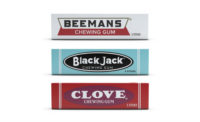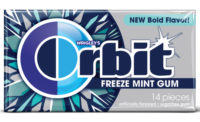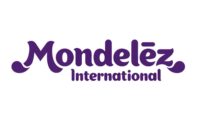Despite its status as a multibillion-dollar category, it’s no secret the gum and mint market is still in need of a boost.
While the gum sector generated $3.07 billion in the 52 weeks ending April 16, according to data from Chicago-based research firm IRI, that’s down 3.1 percent from a year ago. Unit sales dropped by 6.28 percent to 1.92 billion.
Sugar-free gum, the largest segment of the category, pulled in $2.56 billion over the same period, also representing a 3 percent decrease from last year. Revenue for sugar gum dropped by 3.31 percent to $507.5 million.
Edward Taylor, v.p. of U.S. sales and operations for the category-leading Wrigley, noted there isn’t one particular reason why gum sales continue to decline, but he pointed to creativity and consumer awareness as ways to reverse the trend.
“One key area we’re focusing on to sustain long-term growth is keeping gum top of mind with consumers,” he says. “Through campaigns for our largest gum brands, we are reminding people of the reasons why they like gum — it’s fun, connects people and helps clean your teeth and freshen your breath. Offering a variety of fun gum innovations … will also be key.”
Wrigley would know. The Chicago-based company has cornered nearly three-quarters (74+ percent) of the sugar gum market with $376 million in sales over the year ending April 17. And of the Top 10 brands monitored by IRI, Wrigley owns eight of them. Doublemint led the segment with $111.81 million in sales.
Wrigley also occupies 53 percent of the sugar-free gum segment, posting $1.36 billion in sales over the same period. Half of the Top 10 sugar-free brands monitored by IRI belong to the company, with Extra taking the No. 2 spot at $421.7 million. Trident, owned by Mondelez International, led the segment with $454.9 million in sales.
Taylor noted consumers enjoy the “candy-like” experience gum can provide, especially if they’re looking for a low-calorie treat. He pointed to growth in cross-brand Starburst-flavored Juicy Fruit gum. Wrigley also plans to release Juicy Fruit Mixies, which have four different flavors in one 40-piece bottle.
Tyler Merrick, founder of Project 7, a San Clemente, Calif.-based manufacturer of sugar-free gum, also said gum producers — particularly larger ones — need to continue moving beyond regular mint flavors to keep customers interested.
“Innovation is what makes any category grow, and that’s why you need smaller companies like ours in this type of category because they do help drive innovation,” he told Candy Industry in 2016.
Project 7, which pulled in $8.5 million over the year ending April 16, according to IRI, specializes in developing out-of-the box flavors including Birthday Cake, Coconut Lime, Front Porch Lemonade, Grapefruit Melon, Kettle Pop, Peppermint Vanilla, Rainbow Ice and Wedding Cake. The company has recently added Gingerbread Snap, Red Velvet Cupcake and Sour Caramel Apple to its lineup.
“There are a million mint gums out there,” Merrick says. “We don’t stop people from chewing mint gums, but we’re kind of that secondary chew.”
Convenience is another factor. In 2015, Wrigley launched 35-stick Mega Packs under its Extra brand, and the response has been positive, Taylor says.
“Consumers want more gum on hand, and up-sized offerings are growing in demand,” he says. “In the past year alone, we’ve seen the Front End Bulk category overall experience a 17 percent sales increase. In response, we’re expanding our pipeline of Mega Pack offerings this year to include Extra Peppermint and 5 Gum.
Breath fresheners, meanwhile, fared slightly better over the last year, with sales dipping by 1 percent to $825 million and unit sales dropping 2.5 percent to 428.2 million. Plain mints, however, grew by 12.36 percent to $431 million. Unit sales also grew by double digits — 10.91 percent — to 267 million.
Taylor noted innovation is also an important component in the mint segment -- named, of course, for the mint flavor.
“Mints offer a quick burst of breath freshening power, and recently, brands have been able to go beyond typical flavors to give consumers unique takes on traditional mint offerings,” he says. “We’re looking to change things up this year as well by innovating around our most popular gum brand, Extra, to bring it into a new category.”
Wrigley will introduce Extra Chewy Mints, which have a thin, crispy outer shell and a chewy core that has the flavor of Extra gum. Citing Nielsen data, Taylor said only 20 percent of mint offerings are chewable, meaning there is room in the market.
As far as flavor innovation, Perfetti Van Melle has seen success with its Mentos NOWmints line, which are smaller and crunchier than classic Mentos. They’re available in eight flavors: Eucamenthol, Sweetmint, Spearmint, Peppermint, Licorice, Orange, Strawberry and Wild Berry. They also come in colorful metal tins that, according to Perfetti Van Melle’s website, give them “premium status.”
The concept seems to work. NOWmints cracked IRI’s Top 10, earning $22.1 million and moving almost 11 million units over the year ending April 16. That’s up 800 percent from the previous year, according to the data firm.
But no matter how much manufacturers innovate, customers need access to the products. Taylor says retailers should continue to make a variety of options available in check-out lanes, where consumers are most likely to grab a package of gum or mints.
“As part of our Transaction Zone Vision work, we will continue helping our retail partners offer the right mix of choices like beverages, forgotten items like batteries, as well as gum and mints to help meet shoppers’ needs at this critical point in the shopping experience,” he says.










